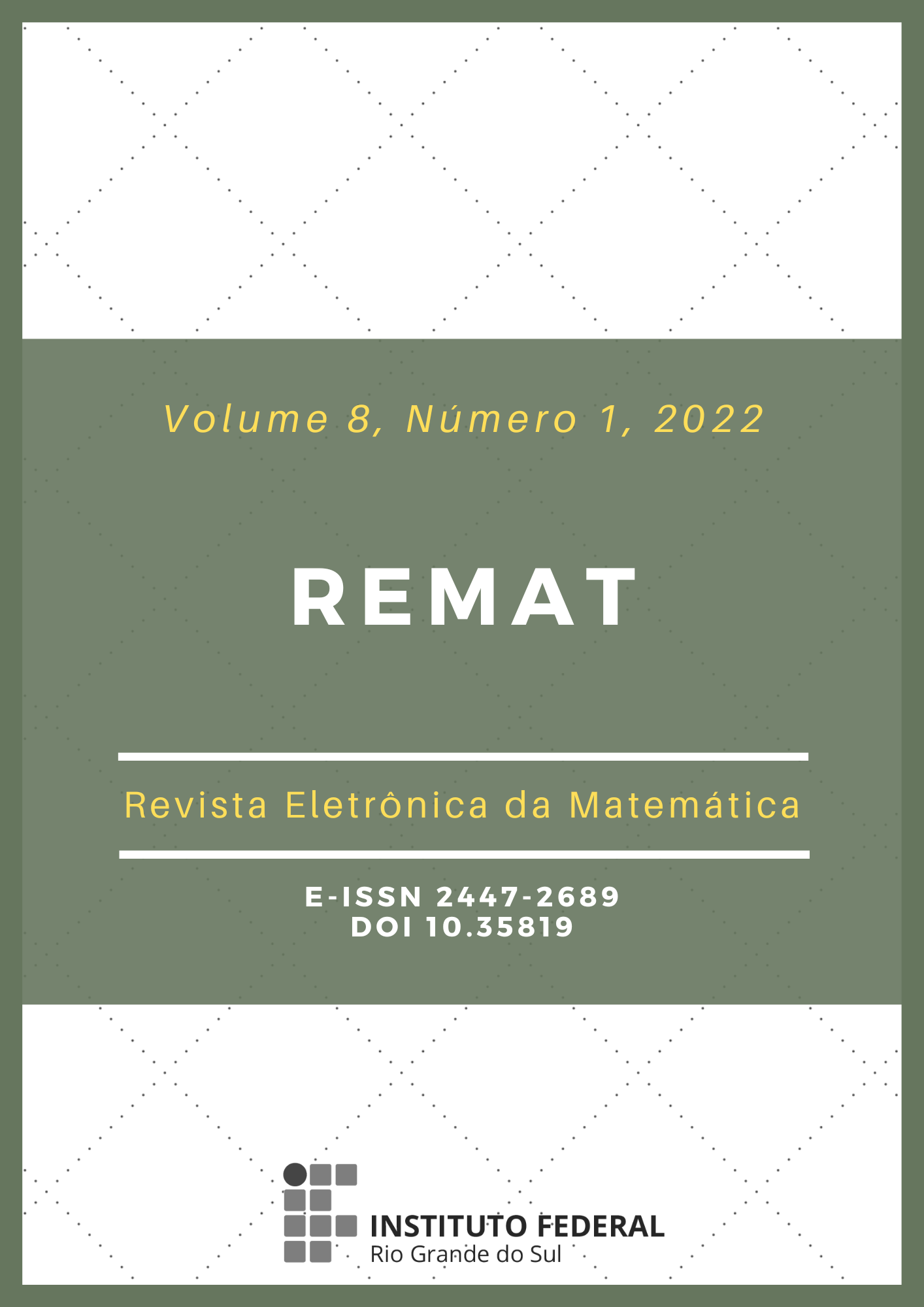Modification in the spatially extended Nicholson-Bailey host-parasitoid model with Coupled Map Lattice
DOI:
https://doi.org/10.35819/remat2022v8i1id5287Keywords:
Difference Equations, Nicholson-Bailey, Coupled Map Lattice, StabilityAbstract
Several population dynamics can be modeled using difference equations, with which time is considered discrete and the state variable is continuous. Among the most known discrete models, the Nicholson-Bailey one stands out for being one of the first to attempt to portray a host-parasitoid dynamics through difference equations. Although it has been used as the basis for the formulation of more complex models, the Nicholson-Bailey model, in its original format, presents unstable coexistence equilibrium for any set of parameters. Therefore, several modifications were proposed to make it closer to what is expected in nature. The present work aims to present the study of a modification in the Nicholson-Bailey model in two stages: the first one consists in inserting a density-dependent growth factor for the host population; the second, in adding the spatial distribution via the Coupled Map Lattice in the already modified model. From the equilibrium stability analysis and numerical simulations, results suggest that with the proposed modification the Nicholson-Bailey model presents stable coexistence equilibrium and the inclusion of space does not contribute to its destabilization. Furthermore, the spatial model exhibits several patterns depending on the choice of parameters, such as waves, spirals and crystalline structures.
Downloads
References
ALLEN, L. J. S. An Introduction to Mathematical Biology. New Jersey: Pearson, 2007.
BATTEL, A. P. M. B.; MORAL, R. A.; GODOY, W. A. C. Modelos matemáticos predador-presa e aplicações ao manejo integrado de pragas. Oecologia Australis, [s. l.], v. 16, n. 1, p. 43-62, 2012. DOI: http://dx.doi.org/10.4257/oeco.2012.1601.05.
BEDDINGTON, J. R.; FREE, C . A.; LAWTON, J. H. Dynamic complexity in predator-prey models framed in
difference equations. Nature, [s. l.], v. 255, n. 5503, p. 58-60, 1975. DOI: https://doi.org/10.1038/255058a0.
BEGON, M.; TOWNSEND, C.; JOHN, L.; COLIN, R.; JOHN, L. H. Ecology: from individuals to
ecosystems. Oxford: Blackwell Publishing, 2006.
BHATTACHARYYA, S.; BHATTACHARYA, D. K. An improved integrated pest management model under 2-control parameters (sterile male and pesticide). Mathematical Biosciences, [s. l.], v. 209, n. 1, p. 256-281, set. 2007. DOI: https://doi.org/10.1016/j.mbs.2006.08.003.
BHATTACHARYYA, S.; BHATTACHARYA, D. K. Pest control through viral disease: mathematical modeling and analysis. Journal of Theoretical Biology, [s. l.], v. 238, n. 1, p. 177-197, 7 jan. 2006. DOI: https://doi.org/10.1016/j.jtbi.2005.05.019.
CARA, E. R. Modelos Matemáticos para o Controle da Praga Grapholita molesta em Culturas de Pessegueiros. Orientadora: Maria Cristina Varriale. Coorientadora: Diomar Cristina Mistro. 2016. 156 f. Tese (Doutorado em Matemática Aplicada) -- Programa de Pós-Graduação em Matemática Aplicada, Universidade Federal do Rio Grande do Sul, Porto Alegre, 15 fev. 2016.
CHAKRABORTY, S. The influence of generalist predators in spatially extended predator-prey systems. Ecological Complex, [s. l.], v. 23, p. 50-60, set. 2015. DOI: https://doi.org/10.1016/j.ecocom.2015.06.003.
COMINS, H. N.; HASSELL, M. P.; MAY, R. M. The Spatial Dynamics of Host-Parasitoid Systems. Journal of Animal Ecology, [s. l.], v. 61, n. 3, p. 735-748, out. 1992. DOI: https://doi.org/10.2307/5627.
DE VRIES, G.; HILLEN, T.; LEWIS, M.; SCHÖNFISCH, B.; MÜLLER, J. A course in mathematical biology: quantitative modeling with mathematical and computational methods. Philadelphia: SIAM, 2006.
EDELSTEIN-KESHET, L. Mathematical Models in Biology. Nova York: Random House, 1988.
FERRERI, L.; VENTURINO, E. Cellular automata for contact ecoepidemic processes in predator-prey systems. Ecological Complexity, [s. l.], v. 13, p. 8-20, mar. 2013. DOI: https://doi.org/10.1016/j.ecocom.2012.09.006.
FRANK, A.; MISTRO, D. C. Um modelo para controle biológico de pragas associado ao uso de pesticida. Proceeding Series of the Brazilian Society of Applied and Computational Mathematics, São Carlos, SP, v. 2, n. 1, 2014. DOI: https://doi.org/10.5540/03.2014.002.01.0014.
KOT, M. Elements of Mathematical Ecology. Cambridge: Cambridge University Press, 2001. DOI: https://doi.org/10.1017/CBO9780511608520.
NICHOLSON, A. J.; BAILEY, V. A. The balance of animal populations: Part I. Proceedings of the Zoological Society of London, [s. l.], v. 135, n. 3, p. 551-598, set. 1935. DOI: http://dx.doi.org/10.1111/j.1096-3642.1935.tb01680.x.
RICKER, W. E. Stock and recruitment. Journal of the Fisheries Research Board of Canada, [s. l.], v. 11, n. 5, p. 559-623, maio 1954. DOI: http://dx.doi.org/10.1139/f54-039.
RODRIGUES, L. A. D.; MISTRO, D. C.; PETROVSKII, S. Pattern Formation, Long-Term Transients, and the Turing-Hopf Bifurcation in a Space- and Time-Discrete Predator-Prey System. Bulletin of Mathematical Biology, [s. l.], v. 73, n. 8, p. 1812-1840, ago. 2011. DOI: https://doi.org/10.1007/s11538-010-9593-5.
RODRIGUES, L. A. D.; VARRIALE, M. C.; GODOY, W. A. C.; MISTRO, D. C. Spatiotemporal dynamics of an insect population in response to chemical substances. Ecological Complexity, [s. l.], v. 16, p. 51-58, dez. 2013. DOI: https://doi.org/10.1016/j.ecocom.2012.07.002.
VAN DEN BOSH, R.; MESSENGER, P. S.; GUTIERREZ, A. P. An Introduction to Biological Control. Nova York: Plenum Press, 1982.
Downloads
Published
Issue
Section
License
Copyright (c) 2022 REMAT: Revista Eletrônica da Matemática

This work is licensed under a Creative Commons Attribution 4.0 International License.
REMAT retains the copyright of published articles, having the right to first publication of the work, mention of first publication in the journal in other published media and distribution of parts or of the work as a whole in order to promote the magazine.
This is an open access journal, which means that all content is available free of charge, at no cost to the user or his institution. Users are permitted to read, download, copy, distribute, print, search or link the full texts of the articles, or use them for any other legal purpose, without requesting prior permission from the magazine or the author. This statement is in accordance with the BOAI definition of open access.













 https://orcid.org/0000-0002-0893-7426
https://orcid.org/0000-0002-0893-7426


















